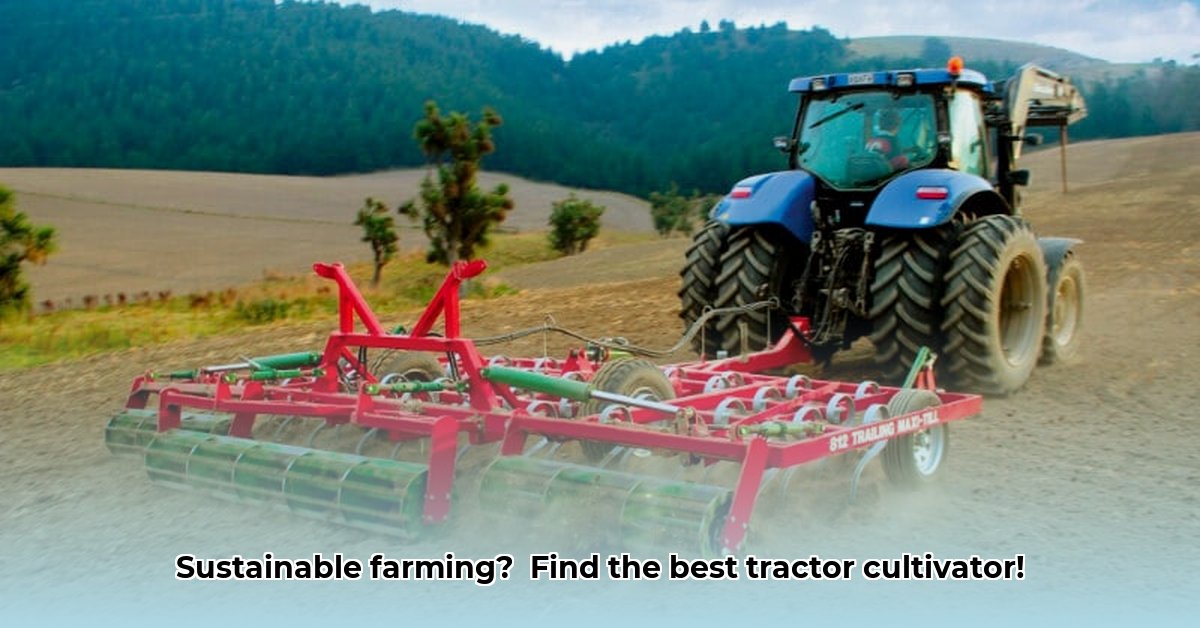
Choosing the right tractor cultivator is crucial for efficient and sustainable farming practices. This guide will help you navigate the options available, considering factors such as fuel efficiency, soil health, and environmental impact. We'll explore different cultivator types, provide a decision-making framework, and offer guidance on sustainable tillage practices and maintenance. For more information, check out this helpful resource on tractor cultivators.
Understanding Tractor Cultivators and Their Role in Sustainable Agriculture
Tractor cultivators are essential implements for soil preparation, playing a vital role in crop production. Their effectiveness in minimizing soil disturbance, optimizing nutrient distribution, and managing weed growth directly impacts the sustainability of farming operations. Fuel efficiency is a critical factor, as minimizing fuel consumption directly reduces greenhouse gas emissions and operating costs. The modern cultivator market offers diverse options, each with unique advantages and disadvantages depending on farm size, soil conditions, and environmental goals. Choosing wisely is paramount for maximizing yields while minimizing environmental impact.
Types of Tractor Cultivators: A Comparative Overview
Several cultivator types are available, each suited to specific soil conditions and farming practices. Understanding these differences is key to making an informed choice. The selection should always consider the specific needs of your farm and the type of crops cultivated.
1. Rotary Cultivators: These pulverize soil into a fine seedbed, ideal for crops requiring delicate seed placement. However, they are generally less fuel-efficient and may increase soil erosion. Their high level of soil mixing is particularly beneficial for lighter soils but can be detrimental to heavier soils, leading to compaction.
2. Chisel Cultivators: These cultivators minimize soil disturbance by breaking up compacted layers without fully inverting the soil profile. They are well-suited for conservation tillage and improving soil aeration and drainage. Fuel efficiency is generally higher compared to rotary cultivators, making them an attractive option for environmentally conscious farmers. However, their limited soil mixing may not be suitable for all soil types or crops.
3. Disk Cultivators: These cut and mix the soil using rotating disks, offering versatility in soil preparation and weed control. This versatility makes them suitable for a larger range of soil types compared to rotary or chisel cultivators. However, excessive use can lead to soil compaction, especially in heavy clay soils. Careful consideration of usage and soil conditions is crucial.
4. Power Source: Cultivators can be powered by gasoline, diesel, or electricity. Diesel engines generally offer greater power and fuel efficiency for larger farms, despite their higher emissions. Gasoline options provide a balance between power and cost-effectiveness. Electric cultivators are becoming increasingly popular, offering zero emissions and reduced noise pollution; however, their range and charging requirements need careful consideration. The optimal power source depends heavily on farm size, operational needs, and environmental priorities. Choosing a fuel-efficient model remains crucial for reducing operational costs and lessening environmental impact. Aren't fuel efficiency and minimized environmental impact key goals for modern sustainable agriculture?
Choosing the Right Cultivator: A Practical Decision Framework
Selecting the optimal cultivator requires a comprehensive assessment of various farm-specific factors:
Farm Size and Topography: Larger farms often benefit from wider cultivators to increase efficiency; however, maneuverability is paramount in smaller fields or those with challenging topography.
Soil Type: Soil texture and structure significantly influence cultivator selection. Heavy clay soils necessitate reduced tillage practices to avoid compaction, while lighter soils may tolerate more intensive cultivation. Are you aware that different soil types respond differently to varying cultivation methods?
Crop Type: Different crops have varying requirements for soil preparation. Some crops need a fine seedbed (e.g., delicate seedlings), while others may thrive with minimal soil disturbance (e.g., certain cover crops).
Budget: Cultivator prices vary significantly among types and manufacturers. Consider not only the initial cost but also long-term maintenance, fuel, and repair expenses. Don't overlook the importance of long-term cost-effectiveness when choosing a cultivator.
Environmental Impact: The cultivator's fuel efficiency and soil-disturbing capacity directly impact the environmental footprint of the farming operation. Prioritizing fuel efficiency, reduced tillage, and the overall impact on soil health are crucial considerations. Consider the long-term benefits of a sustainable approach.
Sustainable Tillage Practices: Optimizing Soil Health
Sustainable farming prioritizes soil health and minimizes its disruption. These practices are fundamental for long-term productivity and environmental stewardship:
Conservation Tillage: Reduces the number of tillage passes, minimizing soil disturbance and erosion.
No-Till Farming: Plants crops directly into the previous year's residue, maximizing soil health and minimizing erosion. This is gaining popularity due to its significant contributions to soil health and overall sustainability, although it requires specialized equipment.
Precision Agriculture: Utilizing GPS-guided technology enhances efficiency by minimizing overlaps and fuel consumption. While the initial investment may be higher, the long-term benefits, including increased yield, reduced fuel usage, and enhanced overall sustainability, can be substantial.
Maintenance and Operation: Extending Cultivator Lifespan and Ensuring Safety
Proper maintenance is crucial for ensuring optimal performance, extending the life of the cultivator, and ensuring safe operation. This involves:
Regular Inspections: Inspect for wear and tear, loose bolts, and damaged parts before and after each use.
Sharpening: Maintain sharp tines and disks for efficient operation and reduced fuel consumption.
Lubrication: Regularly lubricate moving parts to reduce friction and wear, following the manufacturer's recommendations.
Cleaning: Thoroughly clean the cultivator after each use to prevent corrosion and ensure smooth operation.
Safe Operation: Always follow the manufacturer's safety guidelines, using appropriate safety gear.
Conclusion: Cultivating a Sustainable Future
Choosing the right cultivator is a pivotal decision for sustainable farming. By meticulously assessing your farm's needs, soil type, crop requirements, budget, and environmental goals, you can make an informed choice that enhances productivity while minimizing environmental impact. Continued investment in sustainable tillage practices and proper maintenance will ensure long-term operational efficiency and environmental stewardship, securing a sustainable future for your farm.